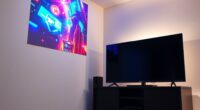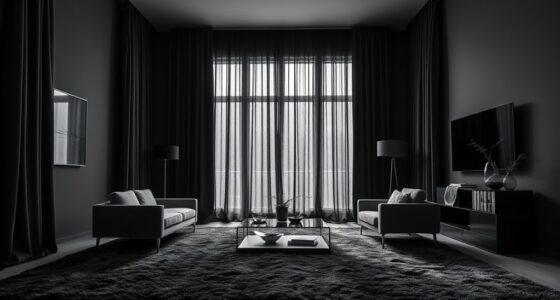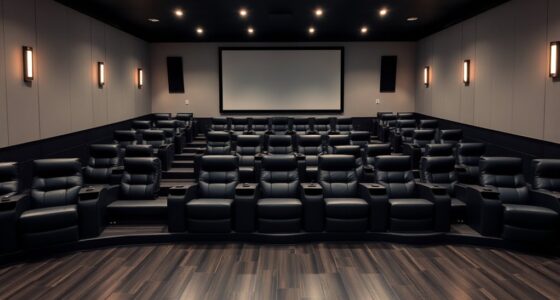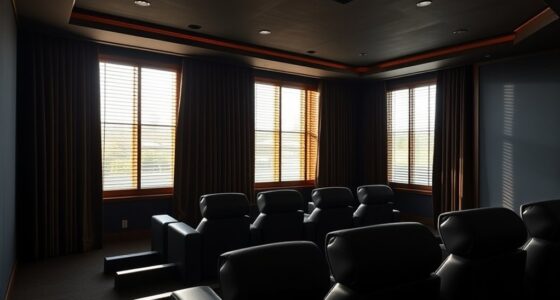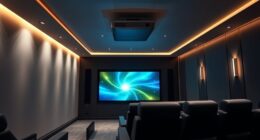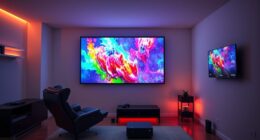Many believe that advanced ambient lighting needs expensive gear, complex installations, or custom fixtures, but that’s not true. Affordable options like LED strips, smart bulbs, and simple layering can create stunning effects without high costs. You don’t need to focus solely on brightness or use room-specific solutions to get great results. If you’re curious about these common misconceptions and smarter strategies, keep going—you’ll find easy, practical tips that anyone can try.
Key Takeaways
- Effective ambient lighting is affordable and achievable with budget-friendly options like smart bulbs and DIY setups.
- Simple, wireless, or plug-and-play fixtures can create sophisticated ambient effects without complex installation.
- Proper layering, color temperature, and automation are more important than brightness alone for quality ambient lighting.
- Advanced strategies are often perceived as complex but can be implemented easily with DIY tips and adaptable, budget-friendly solutions.
- Room-specific lighting needs vary; cozy spaces benefit from warm layers, while work areas require brighter, focused illumination.
You Need Expensive Equipment for Effective Ambient Lighting
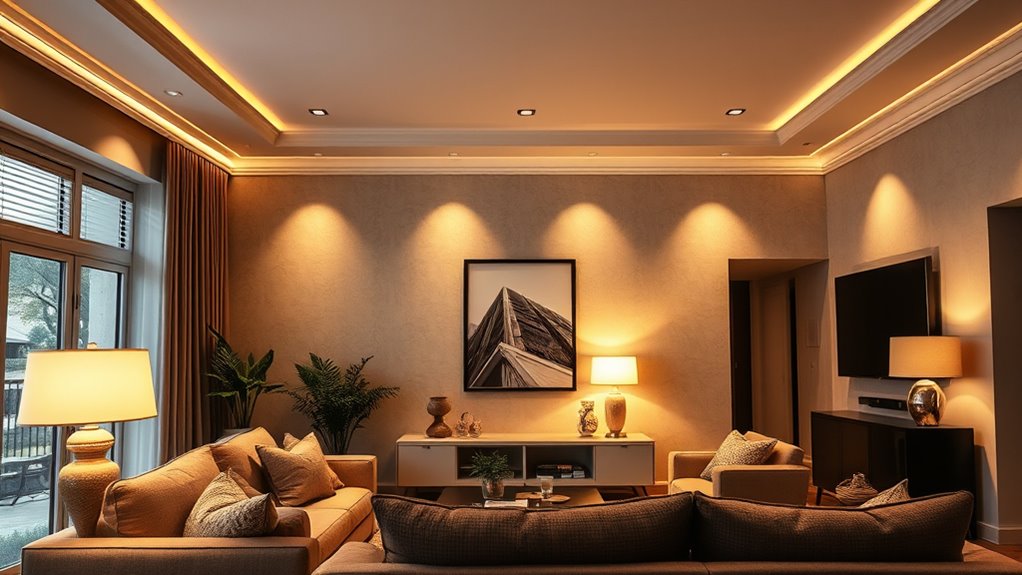
Many believe that effective ambient lighting requires costly equipment, but that’s a misconception. You don’t need to spend a fortune to achieve a cozy, inviting atmosphere. There are plenty of budget options that deliver impressive results without breaking the bank. For example, simple DIY projects like using LED strip lights or repurposing household items can create stunning effects. You can also find affordable smart bulbs that offer adjustable colors and brightness, giving you control without extra expense. The key is to be creative and resourceful—think outside the box rather than investing in expensive fixtures. With a little effort, you can transform your space with effective ambient lighting that’s both affordable and personalized. No need for high-end gear to make a big impact. Additionally, exploring smart home integrations can enhance your lighting setup without requiring significant investment.
All Ambient Light Strategies Require Complex Installations

Contrary to the popular belief that effective ambient lighting requires complicated installations, you can achieve great results with simple setups. You don’t need elaborate wiring or costly equipment. Instead, you can use affordable options that are easy to install and customize. Picture:
Simple, affordable ambient lighting options can transform your space effortlessly and stylishly.
- Plug-and-play LED strip lights that attach easily behind furniture or along ceilings
- Wireless remote-controlled lamps for quick adjustments
- Portable battery-operated fixtures for flexible placement
- Smart bulbs that sync with your devices without rewiring
These simple setups not only save you time and money but also give you full control over your ambiance. You don’t have to sacrifice quality for simplicity. With affordable options, you can create a stylish, inviting environment without the complexity often associated with advanced ambient light strategies. Additionally, choosing cost-effective lighting solutions ensures long-term savings and ease of maintenance.
Brightness Levels Are the Most Important Aspect of Ambient Lighting
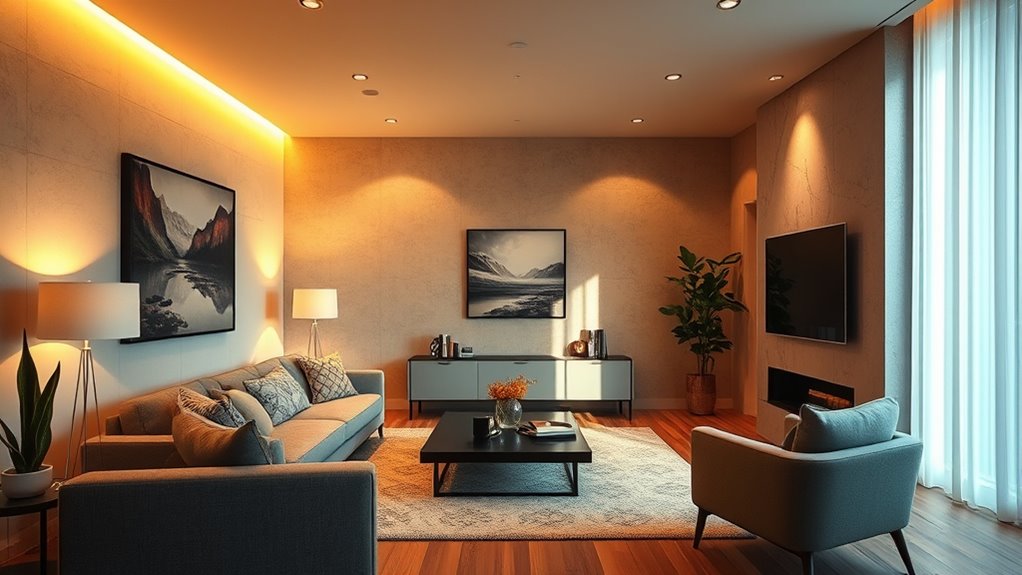
While brightness is important, it’s not the only factor that influences ambient lighting quality. You should also consider color temperature, which affects the mood, and layered lighting to create depth and flexibility. Focusing solely on brightness can limit the potential of your lighting setup. Additionally, integrating advanced automation can optimize lighting based on time of day or activity, enhancing overall comfort and efficiency.
Brightness Isn’t Sole Focus
Focusing solely on brightness levels can be misleading because ambient lighting is about more than just how bright a space appears. While brightness sets the foundation, subtle effects and mood enhancement often come from variations in light intensity and placement. For example, you might:
- Use dimmed lighting to create a cozy, relaxed atmosphere
- Incorporate layered lighting to highlight architectural features
- Adjust brightness for different activities, like brightening a workspace or dimming for movie nights
- Rely on soft, indirect light to evoke calm and comfort
Additionally, understanding the Personality Traits associated with lighting choices can help tailor a space to better reflect mood and individual preferences. These elements show that brightness isn’t the only factor. Thoughtful control of light intensity can influence mood and ambiance, making your space more inviting and dynamic beyond just its luminance.
Color Temperature Matters
Color temperature plays a significant role in shaping the mood and functionality of your ambient lighting, often more than brightness alone. It influences the perceived light quality, affecting how warm or cool a space feels. Warm tones (around 2700K-3000K) create cozy, inviting atmospheres perfect for relaxation, while cooler tones (5000K-6500K) promote alertness and focus, ideal for work areas. Choosing the right color temperature enhances your space’s ambiance and supports your activities. Don’t assume brightness is the only factor; the light’s color temperature deeply impacts how you experience your environment. When designing ambient lighting, prioritize selecting the appropriate color temperature to match your mood and purpose, ensuring your space feels just right. Understanding color rendering can help you select lighting that accurately reflects colors and sets the desired atmosphere.
Layered Lighting Enhances Effect
Brightness levels are the cornerstone of effective ambient lighting because they directly influence how well a space functions and feels. Using layered lighting creates a balanced environment, where different lighting layers work together to achieve the desired effect. When you incorporate layered lighting, you can highlight architectural features, reduce shadows, and create visual interest. Think about:
- Soft, diffused general lighting for overall brightness
- Accent lights to emphasize artwork or focal points
- Task lighting for specific activities
- Dimmer controls to adjust brightness easily
- Proper brightness levels to ensure comfort and functionality throughout the space
Custom Lighting Is Always Necessary for Unique Spaces
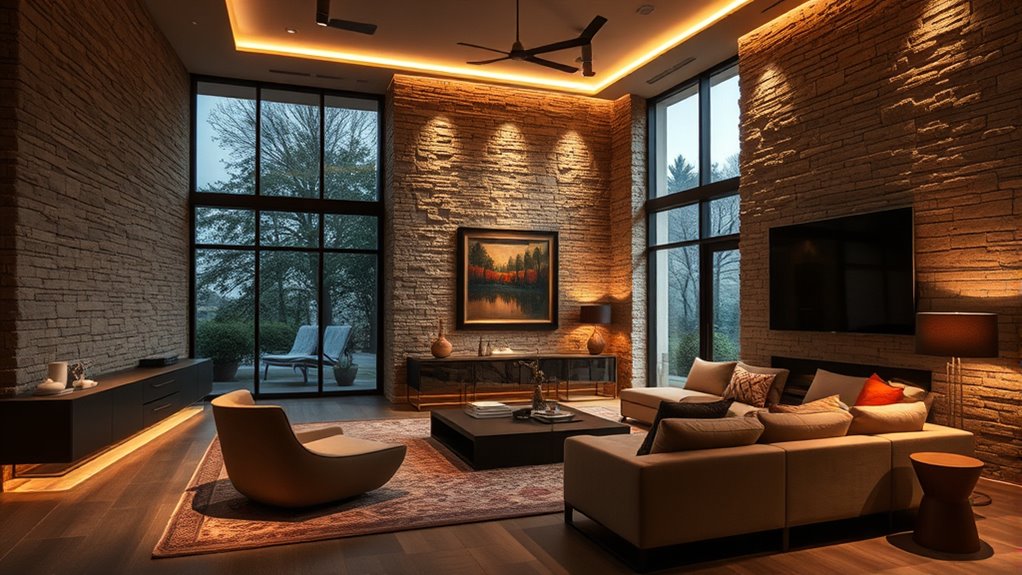
Many assume custom lighting is always needed for unique spaces, but that’s not necessarily true. Design flexibility, cost, and complexity often limit how much customization you can implement. Sometimes, smart, adaptable solutions can achieve your goals without full customization. For example, integrating smart home devices can enhance lighting control and create tailored atmospheres without the need for extensive rewiring or specialized fixtures.
Design Flexibility Limits
Is custom lighting always the only way to achieve perfect ambiance in unique spaces? Not necessarily. While custom fixtures can offer tailored lighting control, they often come with limitations. For example, you might face constraints like:
- Restricted fixture options that don’t fit your aesthetic
- Limited flexibility in adjusting lighting levels
- Compromised fixture durability in challenging environments
- Fixed wiring setups that reduce design versatility
These restrictions can hinder your ability to adapt lighting to changing needs or styles. Relying solely on custom lighting solutions might seem necessary, but integrated systems with advanced controls can provide ample flexibility without sacrificing fixture durability. Understanding these limits helps you choose smarter, adaptable lighting strategies that enhance your space’s ambiance. Additionally, considering best practices for ambient lighting can help optimize your design choices effectively.
Cost and Complexity
While custom lighting often seems like the only way to create a truly unique ambiance, it doesn’t have to be prohibitively expensive or complicated. You can achieve impressive results with smart planning and DIY approaches, even on tight budgets. Many solutions are cost-effective and straightforward, reducing the need for complex installations. For instance, support hours can influence when you plan your setup to avoid peak times or technical issues.
| Budget Constraints | DIY Approaches |
|---|---|
| Limit expensive fixtures | Use smart bulbs and timers |
| Opt for modular systems | Repurpose existing fixtures |
| Prioritize essential zones | Learn simple installation techniques |
| Avoid unnecessary custom builds | Leverage online tutorials |
Ambient Light Is Just About Aesthetics, Not Functionality
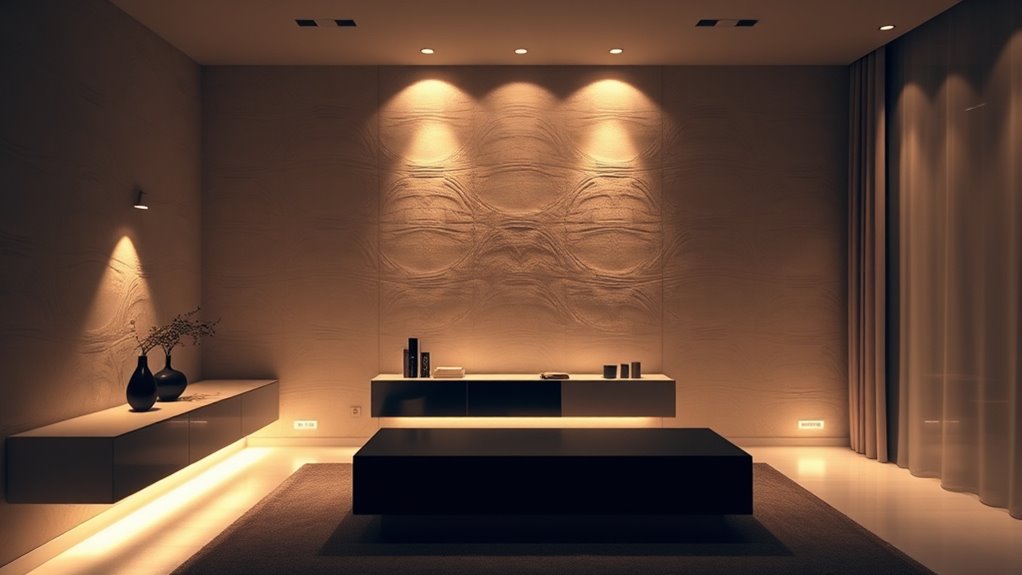
Ambient light often gets dismissed as merely a decorative element, but its purpose extends far beyond aesthetics. It plays an essential role in aesthetic enhancement and mood setting, influencing how you experience a space. Proper ambient lighting can:
- Reduce eye strain during long tasks
- Highlight architectural features subtly
- Create a sense of warmth or coolness to match your mood
- Improve overall functionality by balancing brightness levels
Additionally, understanding sustainable lighting strategies can help you design environments that support both your health and the planet. Rather than just making a room look good, ambient light supports daily activities and emotional well-being. It’s not solely about visual appeal but about crafting an environment that enhances comfort and usability. When you understand this, you see ambient lighting as a critical tool for both mood and function, not just decoration.
One-Size-Fits-All Solutions Work for Every Room

Assuming that a single ambient lighting solution works perfectly for every room is a common misconception. Universal solutions might seem convenient, but they rarely address the unique needs of each space. Different rooms require room-specific strategies to create ideal lighting conditions. For example, a cozy living room benefits from warm, layered lighting, while a workspace needs brighter, focused illumination. Relying on one-size-fits-all solutions can lead to ineffective lighting, wasting energy and missing out on desired ambiance. Instead, tailor your lighting setup to each room’s purpose, size, and layout. This approach ensures you highlight key features and maintain functionality. Remember, customizing ambient light enhances comfort, aesthetic appeal, and efficiency far better than generic, universal solutions.
Advanced Lighting Strategies Are Too Complicated to Implement at Home

Many believe that advanced lighting strategies are too complex to set up at home, but in reality, you don’t need to be a lighting expert to improve your space. With simple DIY tips and budget options, you can achieve impressive results. You might think you need expensive equipment or professional help, but basic tools and creative ideas can go a long way. For example, adding smart bulbs, layering different light sources, or adjusting color temperatures can transform a room. Here’s what you can do:
- Use color-changing LED strips around furniture or ceilings
- Incorporate dimmable lamps for mood control
- Install smart switches for easy automation
- Repurpose affordable fixtures with different bulbs
These strategies are accessible, affordable, and easy to implement yourself.
Frequently Asked Questions
Can Affordable Lighting Options Achieve Advanced Ambient Light Effects?
Yes, affordable lighting options can achieve advanced ambient light effects. With budget lighting and DIY installation, you can create stunning atmospheres without breaking the bank. Using smart LED strips, color-changing bulbs, or layered lighting setups, you’re in control of your ambiance. You just need to plan your design, choose versatile products, and follow simple installation guides. This approach makes advanced ambient lighting accessible and customizable for any space.
Are Complex Installations Necessary for Effective Ambient Lighting in Small Spaces?
You don’t need complex installations for effective ambient lighting in small spaces. Using decorative fixtures and strategic color layering creates a cozy, vibrant atmosphere without hassle. Simple LED strip lights or wall sconces can add depth and warmth, while layering different hues enhances the ambiance. Focus on placement and mixing light sources to achieve an elegant, inviting environment effortlessly, making advanced effects accessible even in compact areas.
How Do Ambient Lighting Strategies Impact Energy Efficiency?
Think of ambient lighting as the heartbeat of sustainable design—steady, efficient, essential. When you choose smart lighting strategies, you actively promote energy conservation, reducing waste and lowering your carbon footprint. These strategies optimize light usage, making your space more eco-friendly without sacrificing comfort. By focusing on energy-efficient fixtures and adjustable controls, you guarantee your ambient lighting supports both your aesthetic goals and environmental responsibility, creating a more sustainable, balanced environment.
Is Professional Assistance Required for Implementing Advanced Lighting Techniques?
You don’t necessarily need professional help for advanced lighting techniques; DIY lighting can be effective, especially with budget solutions. If you’re comfortable with basic electrical work and research, you can design and install ambient lighting setups yourself. However, for complex systems or if you’re unsure about safety, consulting a professional guarantees proper installation and peak performance. This way, you balance cost savings with safety and efficiency.
Can Ambient Lighting Be Easily Adjusted for Different Activities and Moods?
Yes, ambient lighting can be easily adjusted for different activities and moods. You can change the color temperature to create a warm or cool atmosphere, depending on your needs. Dimming controls make it simple to lower or increase light levels, helping you set the right ambiance effortlessly. With these features, you can customize your space quickly, making it perfect for relaxation, work, or entertaining without any hassle.
Conclusion
Many believe that effective ambient lighting demands expensive equipment or complex setups, but that’s not true. In fact, studies show that proper lighting can boost productivity by up to 20%, proving its value beyond aesthetics. You don’t need a one-size-fits-all solution or complicated installs to create a welcoming space. With simple adjustments and understanding your needs, you can transform any room into a functional, beautiful environment without breaking the bank or feeling overwhelmed.

